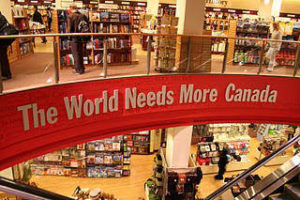Everything You Want to Know About the Canadian Book Market

The Canadian Publishing Landscape Webinar
Amy Collins www.newshelves.com and Lloyd Kelly www.kellyconsultingagency.com
- How big is the Canadian Market really? Why isn’t it approximately 10% of the US market?
- 37M population of Canada – 8M or 21% speak French as their first language
- 2% of the population reported speaking a language other than English or French
Retail and wholesale environment/makeup/footprint
- Indigo/Chapters/Coles: Canada’s leading bricks & mortar book retailer with 97 superstores branded as Indigo & Chapters and 190 mall-based stores under the Coles and Indigo Spirit banners
- CA: Canada’s leading internet retailer
- Costco: 85 warehouses
- Wholesalers: Mass Merchant/Retail (CMMI & News Group)
- Wholesalers: Library (United Library Services, Library Services Centre, Whitehots, & Library Bound)
- Independent Book Stores
- Non-Traditional Retail: Hardware, Gift & Religious stores
2016 Canadian book retail market share
- 33% on-line Amazon
- 38% Indigo/Chapters/Coles
- 18% non-traditional bookstore market (merchandisers) Costco, Walmart, Supermarket, Drug Store and Hardware chains
- 5% Library wholesalers
- 6% Independently operated bookstores
- McNally Robinson – Canada’s premier independent bookstore located in Manitoba, they also operate an educational wholesale div. Skylight Books
- Vancouver Kids Books – Canada’s premier independent children’s books store
Wholesale Mass Merchant/Retail:
CMMI – Wholesaler handling the books category for Walmart, Staples, Rexall and PharmaPlus
annually distributes approx. 100 million magazines, 10 million books, 50,000 creatively packaged promotional book displays, as well as a select number of niche packaged goods products
The News Group (TNG) – Wholesaler handling the book category for Loblaw, Overwaitea Food Group, Safeway, Shopper’s Drug , London Drugs, Home Depot and Loew’s
Costco – 88 warehouse stores in Canada
- Who are the major players? And who are the Canadian publishers?
Penguin Random House, Harper Collins and Simon & Shuster dominate about 65% of the Canadian market primarily with what they import from their US & UK parent companies. They also have Canadian publishing programs that develop and publish indigenous books. However, they also look to purchase Canadian rights to internationally published titles especially if there is a strong and/or unique Canadian angle to the book.
After that, there are a number of Canadian based publishers who make up the balance of the Canadian market.
It may be worth exploring making a separate Canadian publishing deal with multinational and indigenous publishers, for separate Canadian rights, rather than just having the US edition imported and distributed into Canada via the US publisher.
- What would make your book attractive to Canadian publishers?
US platform vs Canadian platform – what is the Canadian angle for your book. Booking Canadian media appearances, interviews or speaking engagements are key.
Need to confirm that the demographics are similar for your book in Canada
Have you had previous books that were distributed here? It may be time to seek out an agent who can help sell Canadian rights to a Canadian publisher.
- What are typical unit sales numbers for the Canadian market?
Discuss Booknet Canada (similar to Bookscan in the US) which is where we get CDN POS data.
- The 500 bestselling titles (of ~400,000 total titles) accounted for almost one-quarter of the total value of sales!
- The average Canadian authored, Canadian Published book sells less than 500 copies net (after returns) – this includes thousands of self-published books that may only sell 50-100 copies
This report, prepared for the Department of Canadian Heritage by Turner-Riggs, provides a profile of the retail book market in Canada.
- A key argument in the report, is that “the supply of books in the Canadian market is growing much more quickly than is consumer demand”
- Almost 17,000 new titles were published by Canadian publishers in 2015, a substantial increase from the 12,000 new titles published in 2008.
- In addition, American publishers produce approximately 300,000 new titles each year.
- The traditional book retail channel – physical stores – still accounts for the majority of consumer book sales in Canada”. The book retail sector is highly concentrated, with a “shift in market share from the independent bookstores to a single national chain throughout the country and regional chains in Quebec”.
- In 2015, nationwide sales of print books through traditional channels stayed relatively flat compared to 2014 levels.
- 2015 saw a decrease of 11% in units sold and a 4.6% decrease in sales revenue from 2014.
- The average list price for trade and mass market paperbacks remained steady at $18.75 and $12.15 in 2015.
- Juvenile Fiction was the best-selling genre in Canada in 2015, with a 29.6% share of total unit sales through traditional book retailers, representing 20% of the value of the total book market.
- General Fiction came in second with a 28% share of units sold, and the same percentage in sales volume.
- These books join the many millions of already published titles that are now virtually all available to consumers via improved search and ordering tools in bookstores and online retailers.
- Nearly 50% of Canadian book consumers purchase books from Amazon.com rather than Amazon.ca, primarily due to better pricing and wider selection.
- The currency-price relationship has created a situation where Canadian retailers can very easily source books outside of Canada at lower cost. This appears to have contributed to a recent spike in parallel importation within the Canadian trade.
- Retailers have set aside more square footage for non-book product over the past decade which generally means less room for books.
- Additionally, book retailers have more space available for higher-margin product, including remainders and retailer-published book inventory. The remainder trade has been characterized as a highly liquid component of inventory in a Canadian bookstore (i.e., it’s rapidly changing and sells quickly at deep discounts from the list price).

 D5 Creation
D5 Creation
This is invaluable information – thank you Lloyd Kelly. And thank you, Amy Collins, for such an amazing summary!